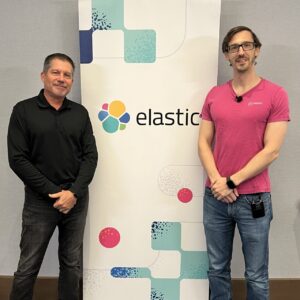|
|
 Kevin Murray and Philipp Krenn presented for Elastic at AI Field Day 5 |
This Presentation date is September 12, 2024 at 14:00-15:30.
Presenters: Kevin Murray, Philipp Krenn
The Precision of Search The Intelligence of AI with Elasticsearch
Watch on YouTube
Watch on Vimeo
Kevin Murray, Group Vice President at Elastic, introduced the company’s evolution from its roots in search technology to its current role in AI-driven solutions. Elastic, founded in 2012, has grown to nearly 3,000 employees and operates in over 40 countries, serving more than half of the Fortune 500. The company’s core strength lies in its search capabilities, which have evolved from basic keyword search to more advanced, context-based search using vector databases and semantic search. Elastic’s search technology is now being applied to AI, particularly in areas like vector search and retrieval-augmented generation, which enhance the relevance and precision of search results. This combination of search precision and AI intelligence is central to Elastic’s offerings, and the company prides itself on its comprehensive approach to search excellence, including the use of embeddings and hybrid search techniques.
In addition to its core search capabilities, Elastic has expanded into the security and observability markets, offering out-of-the-box solutions that leverage its search technology. These solutions are designed to address the challenges of managing large volumes of data in these crowded and competitive fields. Elastic’s approach to security and observability is differentiated by its use of search to drive greater relevance and effectiveness. For example, in security, Elastic’s solutions focus on detection, diagnosis, and remediation, using machine learning-powered detection rules and anomaly detection to identify potential threats. The company recently introduced “attack discovery,” a feature that uses generative AI to recommend remediation steps tailored to an organization’s specific data and context, significantly reducing the time to resolve security incidents.
Elastic’s platform continues to evolve with new features like automatic data import and ESQL, a query language designed to simplify data management and visualization. The company’s architecture is built around its core search capabilities, with shared services for visualization and automation, and solutions for security and observability layered on top. Elastic remains committed to innovation in search technology, working closely with its developer community and large enterprise customers to address scalability challenges and drive better outcomes. As the company continues to grow, it aims to maintain its leadership in both search and AI-driven solutions, helping organizations manage, visualize, and protect their data more effectively.
Personnel: Kevin Murray
Elasticsearch Vector Database
Watch on YouTube
Watch on Vimeo
Philipp Krenn from Elastic provided an in-depth presentation on the capabilities and evolution of Elasticsearch, particularly focusing on its vector database functionalities. He began by giving a brief history of Elasticsearch, which started as a distributed, open-source, RESTful search engine built on Apache Lucene. Initially designed to solve text lexical search problems, Elasticsearch has significantly evolved to include AI, generative AI, and vector search capabilities. Krenn emphasized the importance of combining various data types and formats to enhance search relevance, which traditional databases struggle to achieve. He illustrated this with an example of searching for bars, where factors like ratings, descriptions, and geolocation are combined to provide the most relevant results.
Krenn then delved into the technical aspects of vector search, explaining the hierarchical navigable small worlds (HNSW) algorithm, which is used to approximate and speed up the search process by reducing the number of vector comparisons needed. He highlighted the importance of memory in vector search, as HNSW requires the data structure to fit into memory for optimal performance. Krenn also discussed the trade-offs between different algorithms and the importance of vector compression to reduce memory requirements. He explained how Elasticsearch supports dense vectors and has been improving its capabilities over the years, including adding HNSW for better performance and vector compression techniques.
The presentation also covered the practical implementation of vector search in Elasticsearch. Krenn demonstrated how to create and manage vector representations using Elasticsearch’s APIs, including integrating models from Hugging Face and other sources. He explained the concept of hybrid search, which combines keyword and vector search to provide more accurate and relevant results. Krenn also touched on the importance of combining vector search with traditional filters and role-based access control to refine search results further. The session concluded with a live demo, showcasing how to set up and use vector search in Elasticsearch, highlighting its flexibility and power in handling complex search queries.
Personnel: Philipp Krenn
Elasticseach Vector Database RAG Demo
Watch on YouTube
Watch on Vimeo
Philipp Krenn, Director of DevRel & Developer Community at Elastic, presented a detailed demonstration of the capabilities of Elasticsearch’s vector database, particularly focusing on retrieval-augmented generation (RAG). He explained how Elasticsearch optimizes memory usage by reducing the dimensionality of vector representations and employing techniques to enhance precision while minimizing memory consumption. This optimization is now automated in recent versions of Elasticsearch, allowing users to save significant memory without compromising on result quality. Krenn also highlighted the multi-stage approach to search, where a coarse search retrieves a larger set of documents, which are then re-ranked using more precise methods to deliver the most relevant results.
Krenn emphasized the extensive ecosystem that Elasticsearch supports, including connectors for various data sources and integrations with major cloud providers. This makes it easier for developers to ingest data from different platforms and make it searchable within Elasticsearch. He also mentioned the integration with popular frameworks like LangChain and Llama Index, which are widely used in the generative AI space. These integrations facilitate the development of applications that leverage both Elasticsearch for data retrieval and large language models (LLMs) for generating responses, thereby enhancing the relevance and accuracy of the answers provided by the AI.
The presentation also included a live demo of the RAG capabilities, showcasing how users can connect an LLM, such as OpenAI’s GPT-4, to Elasticsearch and use it to answer queries based on their data. Krenn demonstrated the flexibility of the system, allowing users to customize prompts and refine their queries to get the desired results. He also discussed the cost-effectiveness of running such queries, noting that even with multiple requests, the expenses remain minimal. Additionally, Krenn touched on the importance of security features, such as anonymizing sensitive data before sending it to public LLMs, and the potential for using Elasticsearch in security and observability contexts to provide more intuitive and conversational ways of exploring data.
Personnel: Philipp Krenn









